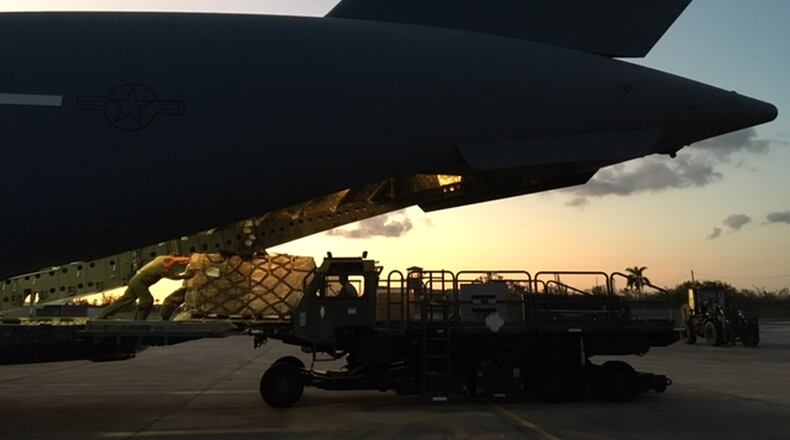Stacey Geiger, 88th Air Base Wing spokeswoman, said there has been no change to the base’s readiness posture.
“As you are already aware, Wright-Patt was identified on Jan. 27 by the Secretary of Defense as one of the installations placed on an increased readiness posture to deploy,” she said. “We currently remain in that status and have not been activated.”
President Biden Thursday re-emphasized that U.S. troops were “not going to Europe to fight in Ukraine.”
An Air Reserve Command spokesman told the Dayton Daily News last week that the 445th Airlift Wing, which is based at Wright-Patterson, remains on alert but has not been activated.
The wing has nine C-17 Globemaster III aircraft. Built by Boeing, the C-17 has been described by the Air Force has being “the newest, most flexible cargo aircraft to enter the airlift force.”
Capt. Courtney Slater, a spokesman for the 178th Wing in Springfield, said the wing’s Airmen “are trained and ready to support NATO and our allies when called upon by the president.”
The wing supports intelligence, surveillance and reconnaissance missions, operating MQ-1B Predator drones.
“However, at this time we are supporting other missions outside of the developing Ukrainian conflict,” Slater said.
Air Force Magazine reported Thursday that 6 F-35s operating from Germany were ordered to NATO’s eastern front by President Joe Biden earlier this week.
Shawn Waldman, chief executive of Miamisburg cyber security business Secure Cyber Defense, said his company was monitoring potential Russian cyber attacks against the United States.
“We are very much in defense mode at the moment monitoring the threat data from the U.S. government and other sources,” Waldman said in a Twitter message to a Dayton Daily News reporter.
“There is one Russian group ‘Shuckworm,’ that we are monitoring and looking for inside our customers networks,” he said. “This cyber threat from them is very real and active. I’m not aware of anything in the U.S. that has been hit. Obviously the cyber attacks against Ukraine are just the tip of the iceberg I believe.”
Dr. Glenn Duerr, a history professor at Cedarville University, said history and logic suggest that Russia and its president, Vladimir Putin, would be more interested in the south and east of Ukraine, as areas seen as more strongly connected by culture, religion and family ties to Russia.
But what is happening now appears to be a Russian attack on all Ukrainian medium or large cities and a probable attempt to install a puppet government, Duerr said.
It’s hard to know where such an attack might stop, he said. There is no NATO or U.S. treaty obligation to come to Ukraine’s aid, but Russian troops moving much closer to the NATO-member nations bordering Ukraine — Poland, Hungary, Slovakia and Romania ― will create new tensions and possibilities for miscalculation.
“Wars don’t just stop arbitrarily at the border’s edge,” he said. “Often they spill over and sometimes shots are fired and there are incidents elsewhere.”
Putin could seek to “protect” those whom he considers “ethnic Russians” in other counties, he added.
The possibility of a far wider conflict can’t be ignored, but he does not believe at the moment that is likely.
“The nightmare scenario is there,” Duerr said. “I don’t see that as likely.”
Dr. Stephen Norris, Miami University professor of Russian history, said it’s impossible to know where this conflict is headed, particularly because many observers did not see the Russian troop buildup around Ukraine progressing to a full-scale military invasion.
“We’re looking at a long invasion, a possible occupation, resistance by the Ukrainians, which is already happening, and there has already been planes shot down, helicopters reportedly shot down, reports of deaths of Russian troops already in Ukraine,” Norris said.
He added: “This is going to get very nasty.”
To date, most people have seen Russian President Vladimir Putin as a rational actor, albeit an opportunist taking advantage of situations as they arise, with some evidence of rationality behind his actions, Norris said.
“It’s hard to say that now, especially with the narrative that he has offered in the last couple of months,” Norris said.
Sean Pollock, a Wright State University history professor who has lived in Ukraine and is literate in Russian, said he was surprised and somewhat disheartened by the day’s events.
“On reflecting on Putin’s speech on Monday, it seems like we need to take him at his word that he is very much concerned about the relationship between Ukraine and the European Union on the one day, and the relationship between Ukraine and NATO on the other,” he said.
Putin is capable of attacking a NATO-member country, but Pollock does not believe he is willing to go that far.
“I don’t think he’s willing to risk nuclear war — and he knows that the West is not willing to risk nuclear war over Ukraine,” he said.
About the Author

